 Overview
Overview
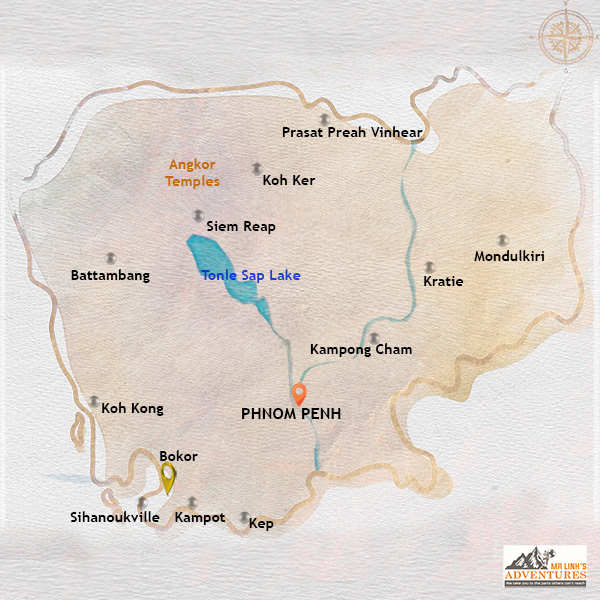
Also known as the Preah Monivong Bokor National Park and Phnom Bokor National Park, the
Bokor National Park offers a unique landscape in the world. It combines majestic mountains, historical ruins, and ancient French colonial buildings.
Protected by the ASEAN Heritage Parks Program in Cambodia, this park is one of only two in the country to receive this distinction.
Located in the highlands of the Damrei Mountains, much of the park is situated 1,000 meters above sea level. Its highest point, Phnom Bokor, rises to 1,080 meters and has given its name to the entire national park. It is also the second-highest peak in all of Cambodia.
The word "Bokor" is a Khmer term meaning "cow's hump," a description that refers to the shape of the mountains in the national park.
The Bokor National Park is also part of the Cardamom Mountains, which stretch across southwestern Cambodia and Thailand.
 Top Attractions
Top Attractions
 Bokor Royal Palace is no longer a ruin
Bokor Royal Palace is no longer a ruin
From colonial ruins to cascading waterfalls and misty forests, Bokor presents an array of "must-sees" that promise an unforgettable experience.
The Bokor Royal Palace
Bokor Royal Palace, located on Cambodia's Bokor Mountain, has gone through several phases in its recent history. Built in 1925 during the French colonial period, it became an iconic ruin for decades, particularly after its abandonment in 1940 and the conflicts that followed.
Nowadays, Bokor Royal Palace is no longer a ruin but a renovated hotel and in operation since 2018, while other historic buildings on the mountain, such as the Black Palace, still remain in a state of abandonment
Popokvil Waterfall
Meaning "Blowing Clouds, or Swirling Clouds" this spectacular two-tiered waterfall is one of Cambodia's most beautiful. Often shrouded in mist, it allows visitors to cool off in its crystal-clear waters. The surrounding lush forest provides a breathtaking backdrop for relaxation and immersion in nature's tranquility.
 Wat Sampov Pram is a charismatic pagoda and a part of what was an old French colonial resort area from the 1920s
Wat Sampov Pram is a charismatic pagoda and a part of what was an old French colonial resort area from the 1920sSampov Pram Temple
Perched dramatically on a cliff-top, this ancient Buddhist temple offers awe-inspiring panoramic views of the Cambodian coastline, the Gulf of Thailand, and distant islands. Its serene atmosphere, combined with the breathtaking scenery, creates a profound sense of peace. Its name - Five Boats Temple - comes from its 5 large rocks, shaped like sailboats facing the sea.
Cloud Forest
Bokor's Cloud Forest is a dense, mysterious ecosystem often enveloped in mist, making it a haven for diverse, rare animal and plant species. Exploring its winding trails offers a unique opportunity to connect with Cambodia's wild beauty and discover its hidden wonders.
 See & Do
See & Do
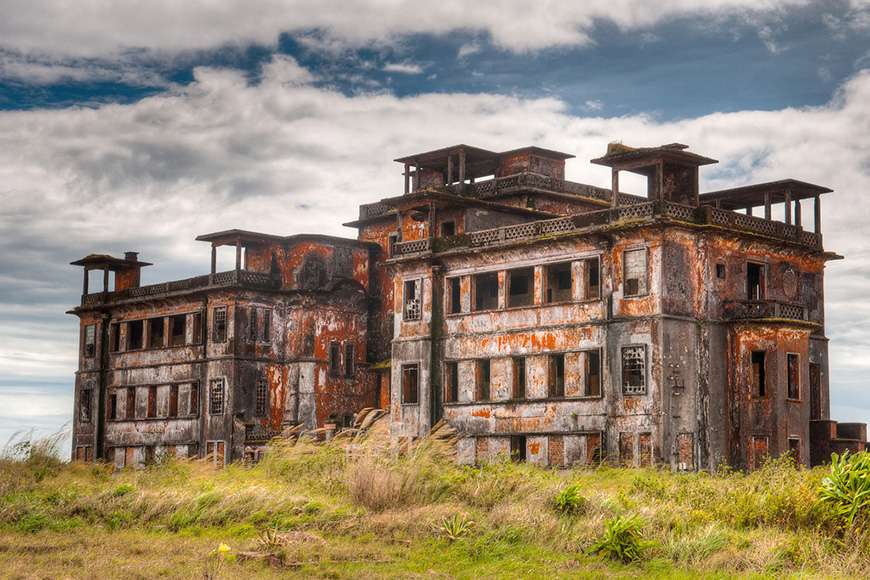 Bokor Hill Resort, in the old times...
Bokor Hill Resort, in the old times...
Bokor Mountain Resort, one of the most visited sites in the national park, reflects Cambodia's French colonial history. Built in the 1920s, this resort was a luxurious retreat for colonists seeking to escape the heat of cities like Phnom Penh.
The resort included a hotel, a palace, and functional buildings such as a post office. However, it was only used for about thirty years before being abandoned due to the Indochina War. It was briefly reopened in the 1960s but was abandoned again when the Khmer Rouge took control of the region in the 1970s.
Today, many buildings in the Bokor Mountain Resort are in ruins, offering visitors a glimpse into the history and architecture of that era. While some buildings in the Bokor Mountain Resort are in ruins, others have been restored or expanded, such as the modern Thansur Sokha Hotel. This luxurious complex offers a wide range of amenities, including a spa, a casino, and several bars and restaurants. It is the perfect place for those who want to enjoy a comfortable stay while exploring the surroundings of Bokor National Park.
 This church serves as the second-oldest standing Catholic church in Cambodia
This church serves as the second-oldest standing Catholic church in Cambodia
One of the most popular remnants in the region is the Catholic church, built by French colonists in the 1920s. Nestled in the heart of a lush jungle, this brick church offers a unique sight in this remote region of Cambodia. Besides being a testament to the past, it provides a stunning view of the national park.
While the structures in the Bokor Mountain Resort reflect Cambodia's colonial past, the national park offers much more than that. Its wild nature and abundant wildlife make it an ideal place for guided hikes.
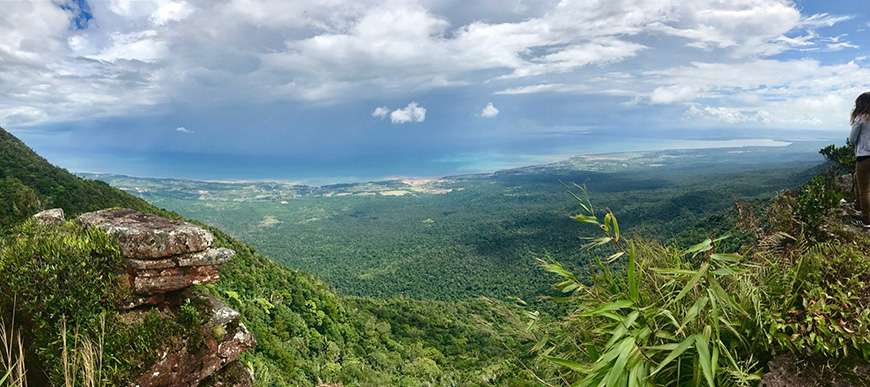 The natural wonders of the Bokor National Park
The natural wonders of the Bokor National Park
The lush forests of the park are home to a variety of rare animals, including the Indian elephant, tiger, sun bear, leopard, macaque, and muntjac deer. Hundreds of bird species, including many brightly colored ones, also inhabit the jungle of the park.
Among the natural wonders of the park are the 100 Rice Fields (Veal Sre Mouy Roy), a unique geological phenomenon. Although it is actually a field of rocks, many say it resembles a series of rice fields.
Visiting the Povokvil Waterfalls offers a pleasant hike of about three hours round trip through lush greenery.
Not far away is the former Black Palace, the former summer palace of King Sihanouk, who reigned between 1941 and 1955. Although abandoned for several decades, it remains a fascinating place to explore.
In addition to hiking, many visitors from Kampot or Kep choose to rent a motorcycle or scooter to explore the main attractions of the national park independently. For those who prefer a bit more comfort, 4x4 tours are also very popular.
 Go Green
Go Green
If you are looking for a personalized adventure, Mr. Linh's Adventures offers tailor-made tours in Bokor National Park. You can explore the park's most iconic sites, discover its culture and history, and meet local communities. The guides from Mr. Linh's Adventures are experts in the region who will share their passion for Cambodia and its wild nature with you.
 Heritage
Heritage
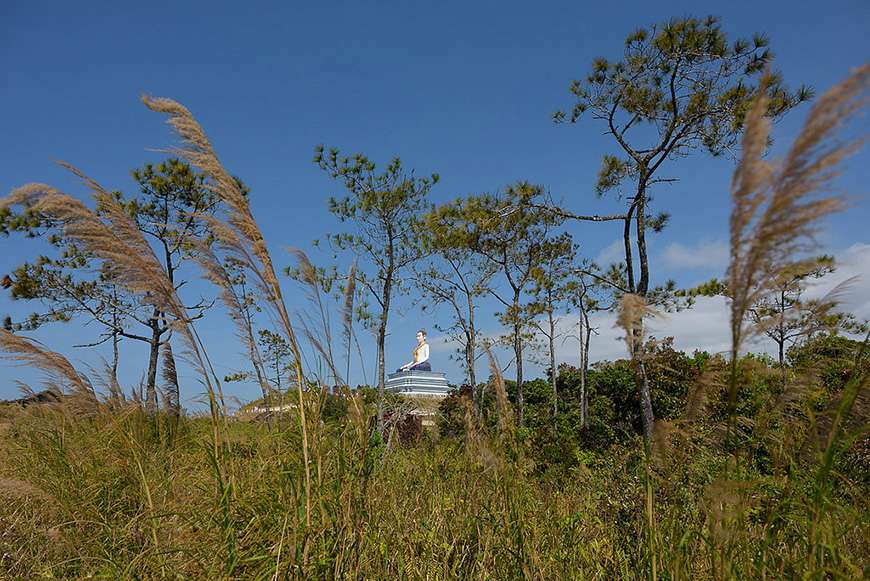 The Goddess Lok Yeay Mao is a deity that is worshipped mainly in the coastal provinces of Cambodia
The Goddess Lok Yeay Mao is a deity that is worshipped mainly in the coastal provinces of Cambodia
Although Bokor National Park is primarily a place of history and nature, it harbors a few cultural treasures worth discovering.
One of these wonders is the 29-meter-high statue of Lok Yeay Mao, a mythical heroine of Cambodian Buddhism, particularly revered in the province of Kampot. She is considered the protector of travelers and hunters.
Wat Sampov Pram, a temple located in the mountains of the national park, is another place not to be missed. It is worth a visit for its religious roots as well as its stunning statues and artistic architecture. Built by King Monivong in 1924, this active temple is home to a community of monks. It is a highly visited place by visitors to the region, but it also attracts a steady flow of Buddhist devotees. The monks regularly hold meditation, music, and chanting sessions and invite visitors to participate or observe.
Food offerings brought by the faithful attract monkeys from the region. Some of the most mischievous monkeys are now in cages as the monks had to limit their impact on religious offerings! Besides the cultural knowledge that can be gained there, the place also offers a stunning view of the national park when the clouds are not too low.
The Damrei Mountains, where Bokor National Park is located, are considered sacred in Khmer culture. The park, and especially Wat Sampov Pram, are important celebration sites during Buddhist festivals.
One of the most important festivals is Khmer New Year, Cambodia's largest annual celebration, which takes place every April. During this time, many residents visit the temple to receive blessings from the monks and make offerings.
 Food & Drinks
Food & Drinks
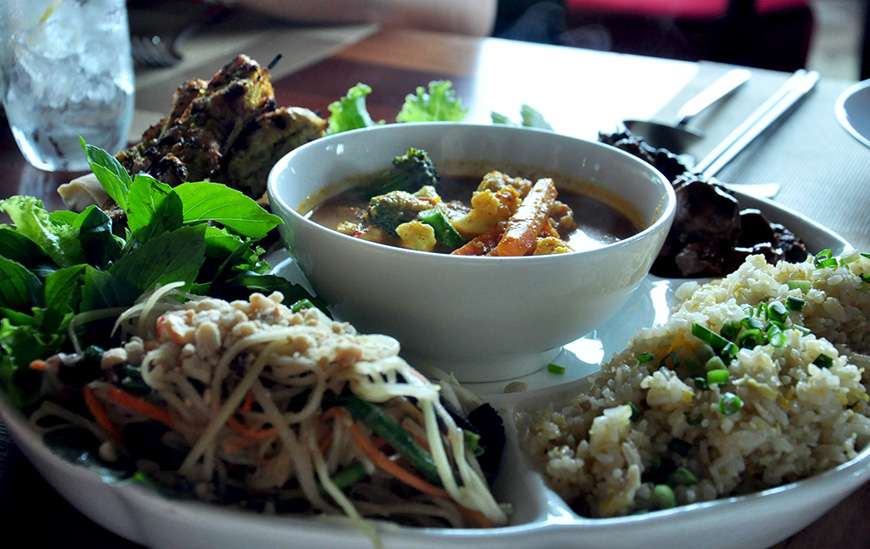 Typical khmer dishes
Typical khmer dishes
The Kampot region, where Bokor National Park is located, is renowned for its Kampot pepper, grown in black, white, and red varieties. This spice, cultivated in the region since the arrival of the first Chinese settlers in the 13th century, experienced significant growth in the 19th century.
Although Bokor National Park was an important site for pepper cultivation, the departure of the French and the civil war hindered production for several decades. While Kampot pepper is still grown on a small scale in the national park, most pepper plantations that can be visited are just outside the park's geographical area.
Most restaurants in Bokor National Park are located in hotels and tourist complexes, offering a variety of international and traditional Cambodian dishes. Given the park's proximity to the sea and the famous seafood that comes from this particular part of the coast, menus also feature an abundance of seafood, which can be served flambéed at the table.
 Directions
Directions
Location
Bokor National Park is located in the province of Kampot, southern Cambodia.
How to get there
You can get there by bus or taxi from Phnom Penh or Sihanoukville. The ticket price varies depending on the mode of transportation and distance.
Best time to visit
The best time to visit the park is from November to April, during the dry season.